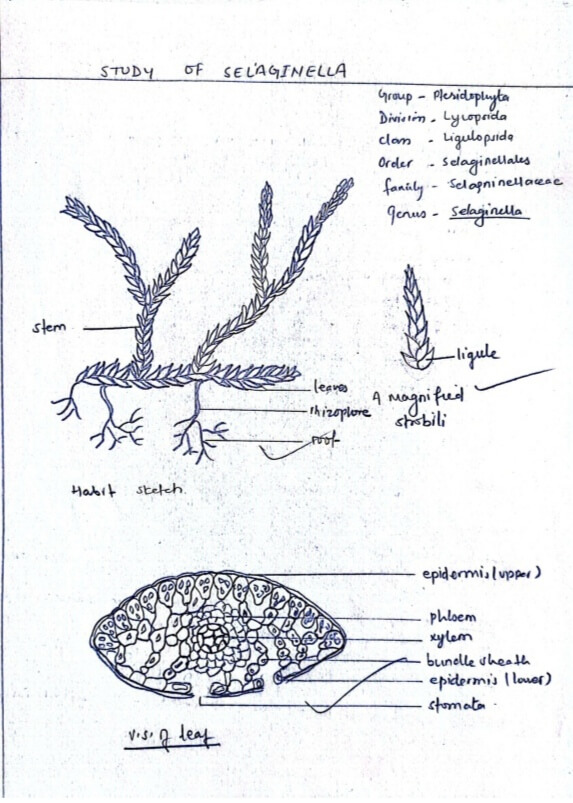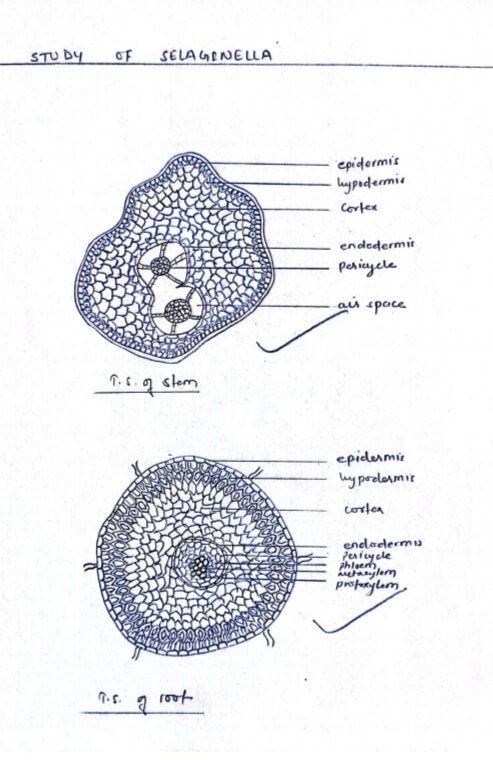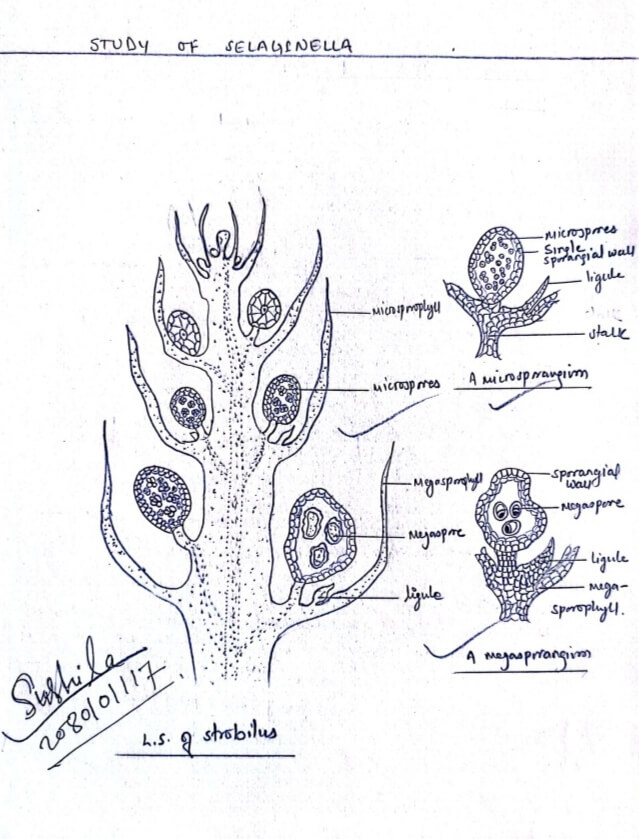COMMENTS ON SELAGINELLA
Habit
Selaginella is a cosmopolitan, perennial herb Mostly confined in tropical rain forest under dry and humid conditions.
Morphological structure of sporophytic plants.
It is well differentiated into stem, leaves, rhizophores and roots.
i) stem:
The stem of a commonly found plant is dorsiventral and prostrates on ground. It is ratified by branching dichotomously and some of the branches up to developed sporophylls on the top.
ii) Leaves:
The leaves show dimorphism bearing large and small sized leaves which are arranged in four vertical rows. Each leaf is a small lanceolate type.
iii) Ligule:
The leaves are ligates bearing small membranous ligules on the dorsal or ventral surface.
iv) Rhizophore:
The stem gives rise to elongated, cylindrical colorless downwardly growing leafless branches called rhizophores.
v) Strobilus:
The strobili are found at the tip of erect branches, intermingling with the sporophylls.
Internal structure of leaf
i) Epidermis:
There are two district upper and lower epidermal layers made up of one celled layer of parenchymatous cells containing discoid chloroplasts. The lower epidermis is provided with stomata.
ii) Mesophyll tissue:
The region between upper and lower epidermis is filled with elongated thin walled loosely arranged mesophyllous tissue enclosing large air spaces. The cells are generally chlorenchyma tous type containing chloroplast.
iii) Vascular bundle:
It is very simple concentric with a central xylem surrounded by few phloem layers. The xylem has annular and spiral tracheids. The phloem lays have a sieve tube.

Internal structure of stem
i) Epidermis:
The outermost superficial single celled layer is composed of thin walled parenchymatous cells which are externally cutinized.
ii) Cortex:
A multilayered region composed of 3-5 thick walled fibrous sclerenchymatous hypodermis followed by parenchymatous inner layers. In xerophytic species, the entire cortex may be sclerenchymatous Cells.
iii) Endodermis:
It is a specific layer that originated from some of the cells of the last cortical layer and elongated to meet the pericycle layer. It bears a casparian band.
iv) Pericycle:
A single celled layer is composed of compactly arranged parenchymatous cells surrounding the stele.
v) Stele:
The stele is centro-xylic with a mass of central xylem surrounded by few layers of phloem. The xylem is exarch.
Internal structure of root
i) Epidermis:
It is the outermost protective layer made up of compactly arranged parenchymatous cells without cuticle, but with root hairs.
ii) Cortex:
A wide region consisting of 3-5 layers of sclerenchymatous hypodermis and multi layered sclerenchymatous layers below it.
iii) Endodermis:
A single celled layering of barrel- shape compactly arranged with casparian bands at their radial walls.
iv) Pericycle:
A prominent layer of one thick call below the endodermis surrounding the stele.
v) stele:
A typical prostele with exarch and mono-arch xylem. The centrally placed Metaxylem has only one group of protoxylem at one peripheral side. The phloem completely encircles the xylem.

Asexual reproductive structure.
i) Strobili:
The reproductive spores are developed at the terminal ends of branches as compactly arranged sporophylls called strobili. The sporophyll is a leaf-like structure bearing a ligule and a small stalked sporangium at the adaxial side near the base; it is heterosporous bearing two kinds of spores namely Microspore and Megaspore. The sporophylls bearing microsporangia and megasporangia are called microsporophyll and megasporophyll respectively. The microsporophyll and Megasporophyll bear microsporangia and megasporangia respectively.
ii) Sporangium:
It consists of a short stalk and elongated body covered by a double layered sporangial wall.
iii) Microsporangia:
It is small, smooth, red, yellow or brown in colour and encloses numerous minute microspores. Each microspore is coated with an outer ornamented thick exine layer and inner thin intine layer.
iv) Megasporangia:
It is large with pale white colour. It bears four large megaspores tetrahedral in shape with triradiate ridges on it. It is surrounded by a double walled coat – the outer thick ornamented exine or exospore and inner thin entire or endospore.

